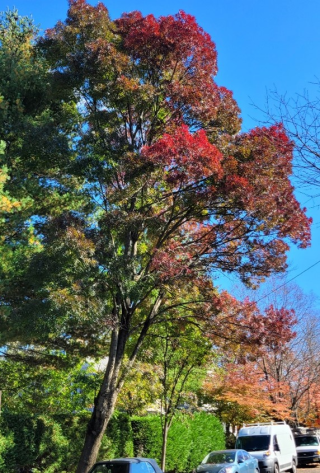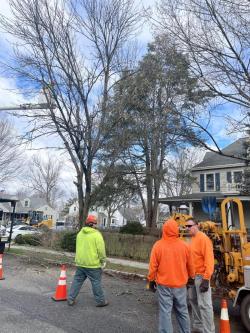American Ash

March 2024 Tree of the Month: American Ash
The common name, American Ash, can refer to two species in the Fraxinus genus: Fraxinus americana, or, Fraxinus pennsylvanica. We can find both of these species growing in Cranford, and the trees are native to eastern and central North America. The botanical name comes from the same genus as the Old World ash species. It belongs to the olive family and has some unusual relatives in the plant world, including forsythia, privet, lilac, and olive.
A dioecious plant, ash trees have male and female flowers that grow on different trees, although a single tree can have both on separate branches. Ash seeds, also known as “keys,” ripen in September and October, during which time they turn from green to brown. To sow them successfully, the seeds need to be kept outside for their first winter, a full summer, and then the following winter before putting them in soil. The keys are attractive to finches, cardinals, grosbeaks, grouse, turkey, and quail.
Ash trees are wonderful ornamental trees. Their dark green foliage creates deep shade and they have remarkable fall color ranging from sunny yellow to deep burgundy. They are popular in urban areas and the wood is useful in the timber trade for baseball bats, bowling alleys, and other furniture.

Our DPW tree crew hard at work, removing a dead ash tree
that was one of many victims of the emerald ash borer.
Sadly, the planting of new ash trees is no longer recommended, and the Township Shade Tree Commission will be monitoring Cranford’s existing ash trees for evidence of the Emerald Ash Borer (EAB), an invasive insect whose larvae typically will kill a tree within three to five years of infection. EAB larvae essentially starve the tree of nutrients by tunneling throughout the phloem and sapwood layer of the tree. EAB is complicated to eradicate, and we recommend that residents monitor any ash trees on their property for this pest and consult with an arborist to provide preventative treatment, if feasible. If an infected tree will not cause harm to humans or property (e.g., falling limbs), the recommendation is to leave the tree alone. Standing dead trees provide habitat for many species including cavity-nesting birds.
As of the Township’s last survey from the fall of 2016, there were 265 ash trees on town property. The Shade Tree Commission will be inspecting these trees regularly for signs of infection and may need to remove them for safety reasons. Please notify the commission here if you notice an ash tree in distress.
Fun Fact: The nation’s largest white ash tree is at 100 Ridgedale Avenue, Madison, N.J. Its circumference is 255 inches and its height is 115 feet, with a crown spread of 111 feet. It started growing in 1615, making it 409 years old.
